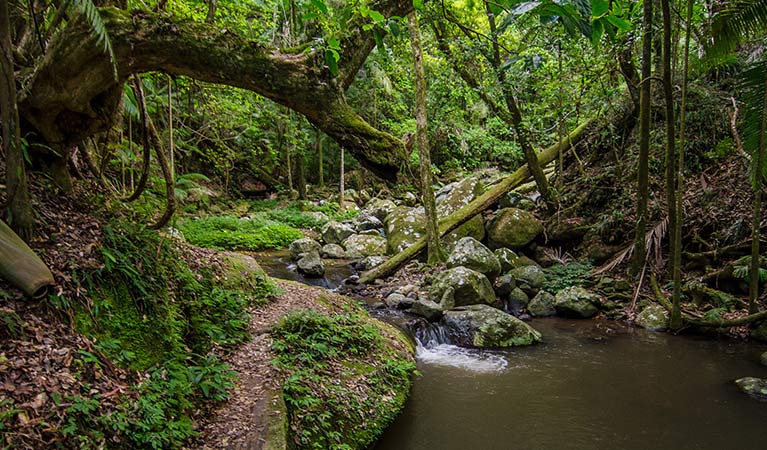Border Ranges National Park
Overview
World Heritage-listed Border Ranges National Park offers scenic walks, cycling, drives and breathtaking views, near Murwillumbah. Enjoy a school excursion or camp amongst the gondwana rainforest.
Read more about Border Ranges National Park
Border Ranges National Park, part of the Gondwana Rainforests of Australia World Heritage Area is a large area of wilderness that protects untouched rainforest and unique plants and animals connected to the ancient supercontinent of Gondwana.
There are countless opportunities to explore the abundant wonders of the rainforest throughout this rare haven. You can travel around Border Ranges National Park along the Tweed Range Scenic Drive touring route (part of the Rainforest Way) – stopping wherever you like for a closer look at this special landscape. Try the short Palm Forest walking track through subtropical rainforest or take the more difficult Booyong walk that leaves from Sheepstation Creek campground.
You’re bound to find a beautiful spot for a picnic or barbecue lunch and be sure to stop off at some of the park’s lookouts along the way to enjoy magnificent views of the spectacular crater escarpment. Photographers will love capturing billowing waterfalls, views of Wollumbin-Mount Warning and lush rainforest plants.
The park is easily accessible from Kyogle and Lismore; however if you’d prefer to sleep under a blanket of stars and be woken by birds, head to one of the park’s campgrounds.
Local alerts
For the latest updates on fires, closures and other alerts in this area, see https://uat.nswparks.cloud/visit-a-park/parks/border-ranges-national-park/local-alerts
Map
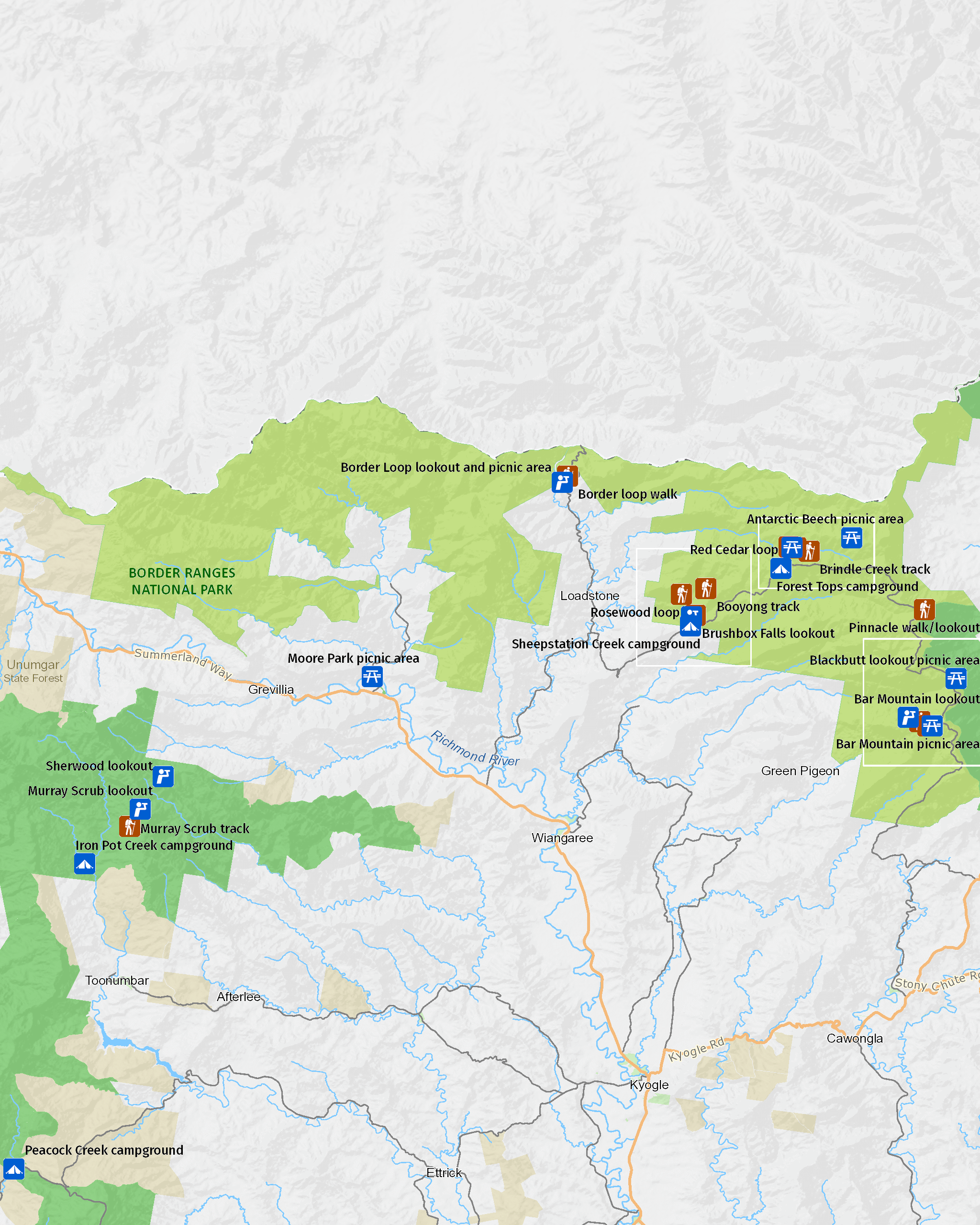
Map
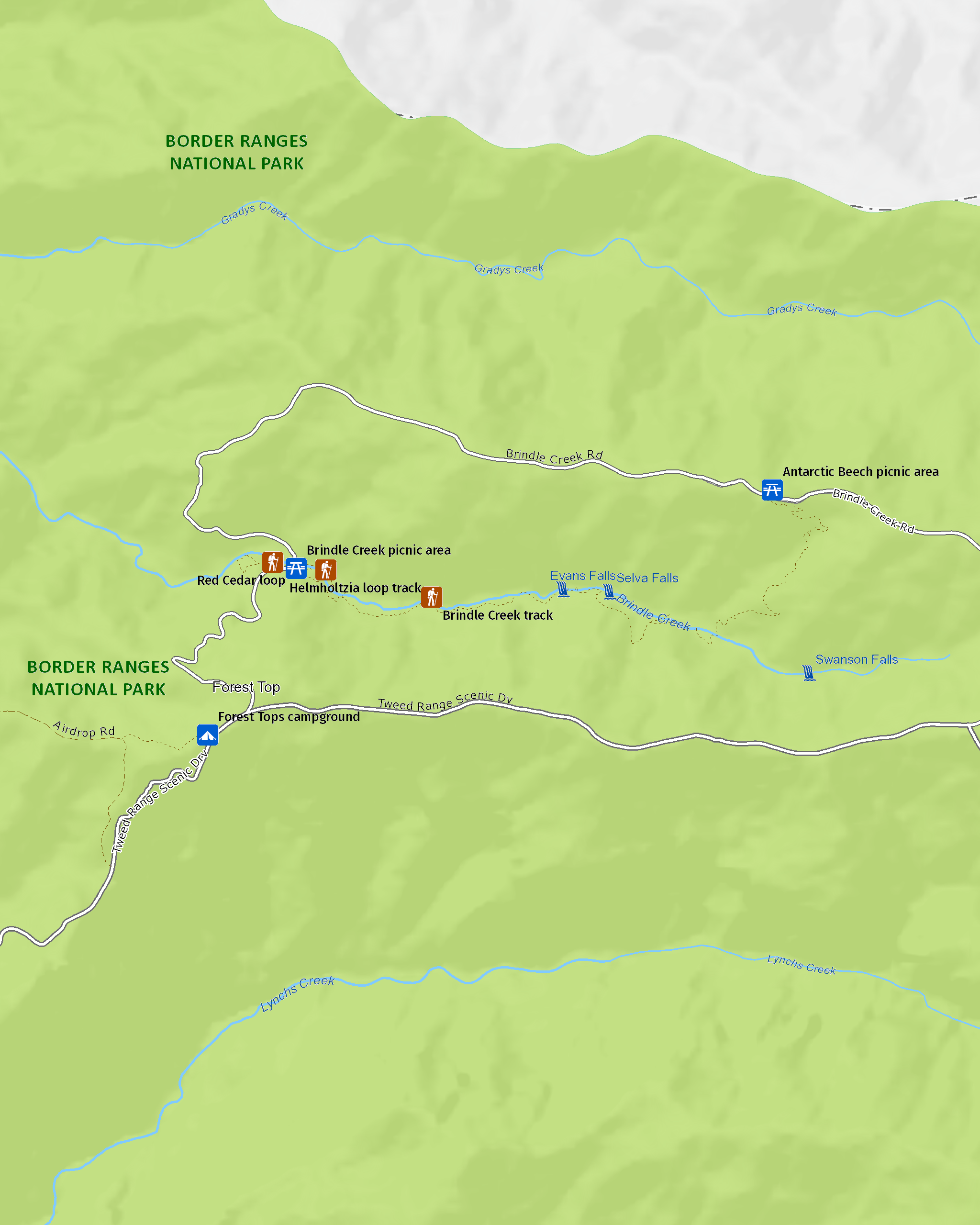
Map
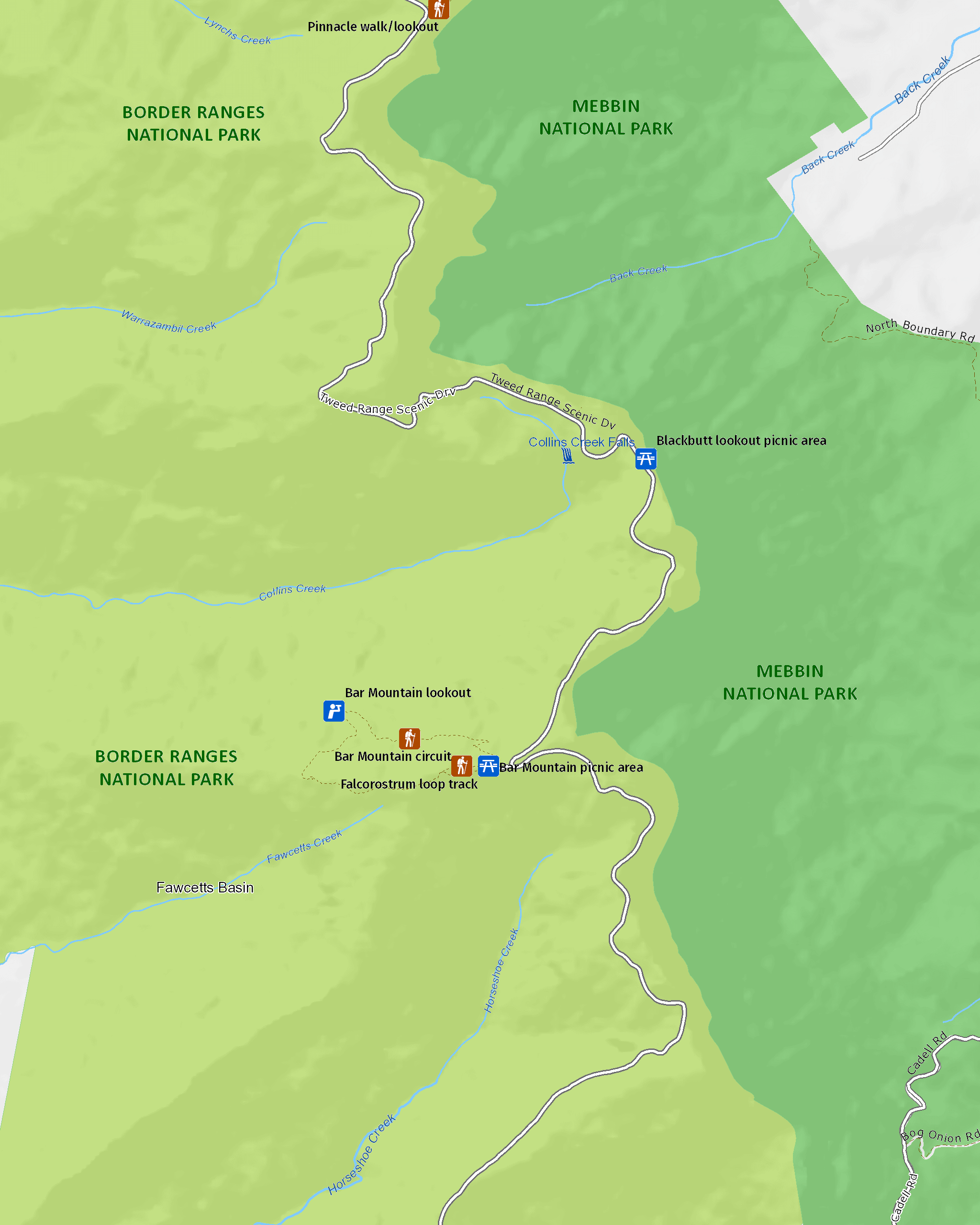
Map
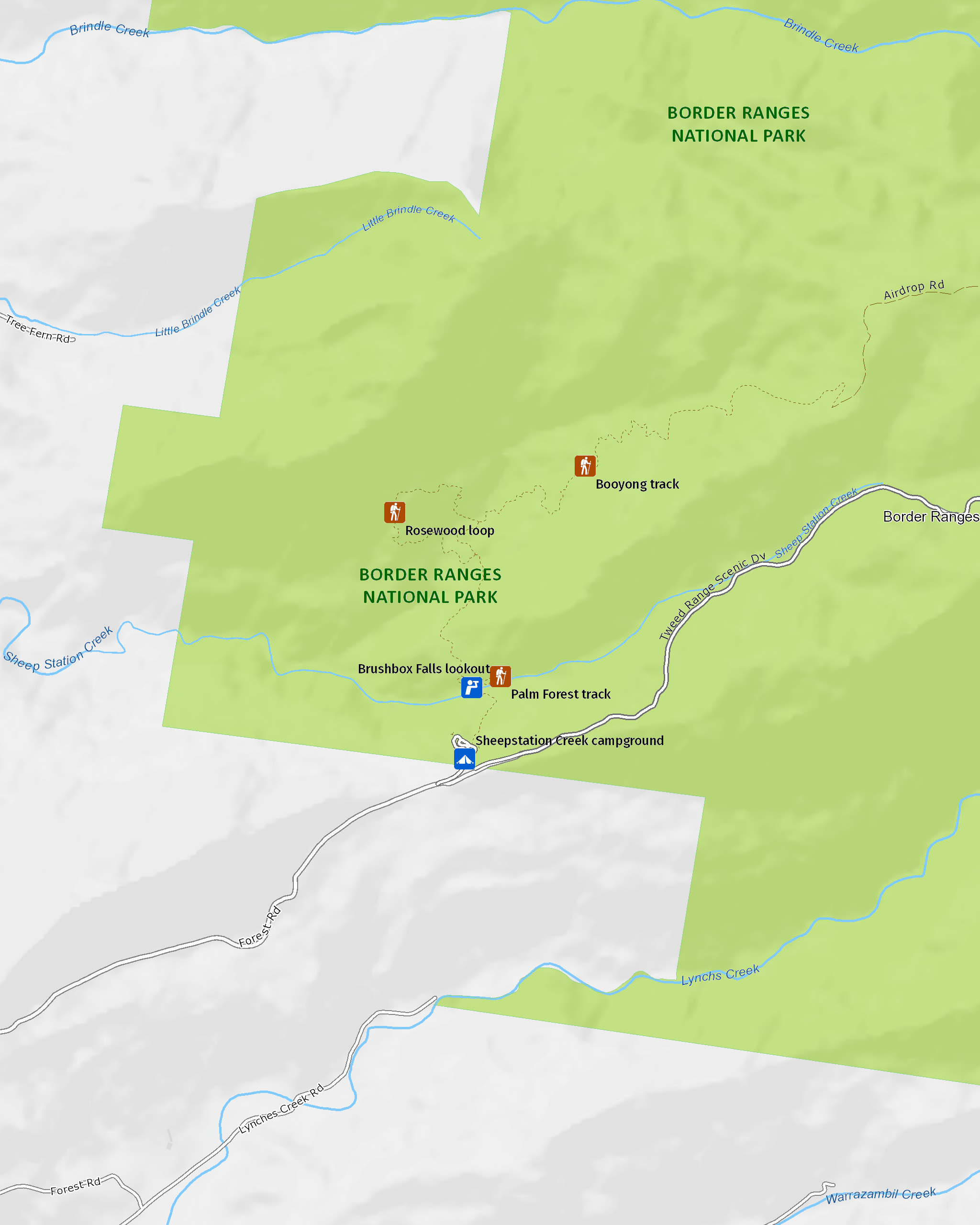
Map legend

Contact
- in the North Coast region
Border Ranges National Park is always open but may have to close at times due to poor weather or fire danger.
-
Park entry fees:
$8 per vehicle per day.
Buy annual pass. -
-
Kyogle office
02 6632 0000
Contact hours: Monday to Friday, 8.30am to 4.30pm. - 136 Summerland Way, Kyogle NSW 2474
-
Email: npws.richmondriver@environment.nsw.gov.au
-
Kyogle office
Visitor info
All the practical information you need to know about Border Ranges National Park.
Maps and downloads
Nearby towns
Nimbin (22 km)
Nimbin is the counter-culture capital of Australia. It's set in a beautiful green valley pierced with limestone spires.
Kyogle (30 km)
Kyogle is an attractive timber-milling town surrounded by rainforest. It's set on the Richmond River at the base of Fairy Mountain.
Murwillumbah (50 km)
Murwillumbah is rich dairy, sugar cane and banana country. It's located on the banks of the Tweed River and set in the Tweed River Valley against a backdrop of rainforest-clad hills.
Learn more
Border Ranges National Park is a special place. Here are just some of the reasons why:
World Heritage wonder
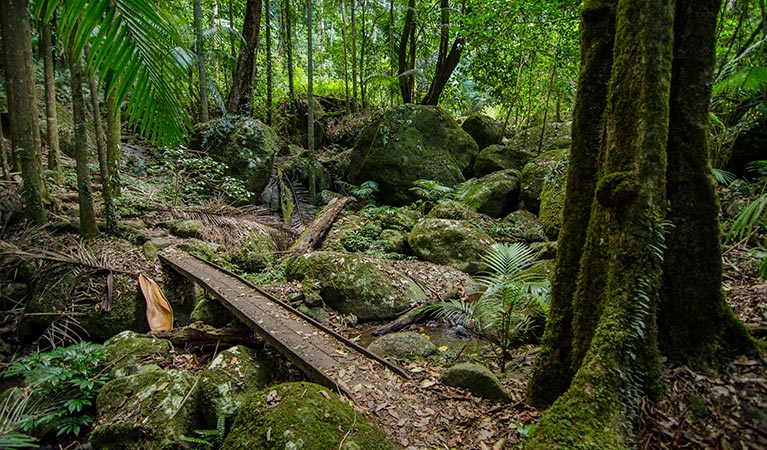
The rainforests of the Border Ranges National Park are part of the Gondwana Rainforests of Australia World Heritage Area. World Heritage Areas are irreplaceable sources of life and inspiration - places of such value that the international community has agreed they must be conserved for all time. You can explore this World Heritage-listed rainforest on one of the many walking tracks, like the short Pinnacle walk that provides spectacular views of Wollumbin and the Tweed Valley 1km below.
- Bar Mountain circuit Take the short and easy Bar Mountain circuit walk to the lookout where you’ll enjoy panoramic views of World Heritage-listed rainforest.
- Border Loop walk Walk the short and easy Border Loop walk through World Heritage-listed rainforest. Enjoy spectacular views from the lookout and finish with a picnic at the end.
- Border Ranges 360 experiences Discover some of the rare and remarkable animals, plants and habitats that make Border Ranges National Park special, with our interactive 360-degree images..
- Brindle Creek picnic area Pack up a picnic and set off along the Tweed Range Scenic drive to explore Border Ranges National Park. Stop off at Brindle Creek picnic area for a picnic and walk.
Picture perfect
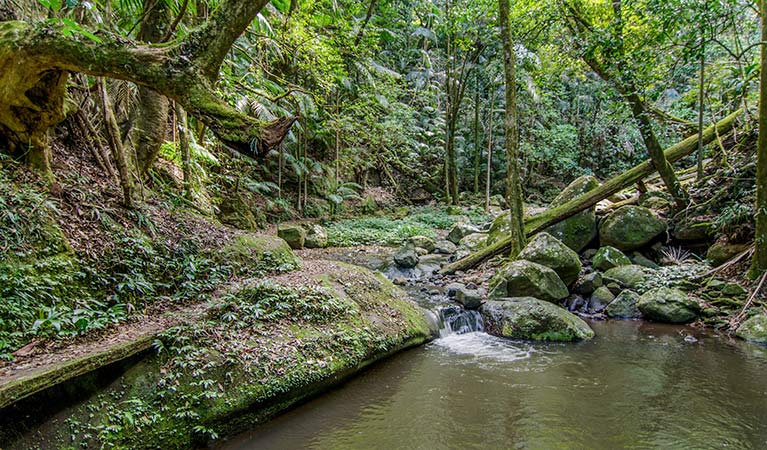
A landscape photographer's dream, you'll be spoilt for choice in trying to capture the sheer scale and beauty of this epic rainforest from the many lookouts dotted throughout the park. Be sure to carry your camera up to the Pinnacle lookout at sunrise for a breathtaking birds-eye view of the crater escarpment all the way down to the NSW coastline. Don't forget to change your camera setting to panoramic for the perfect mantelpiece shot.
Abundant wildlife

Being part of the Gondwana Rainforests of Australia World Heritage Area, makes this park a truly special place to visit. This region has the highest concentration of marsupial, bird, snake and frog species in Australia, so you're bound to come across a cute creature or two during your visit. While you're in the heart of this remarkable rainforest make sure you listen out for the call of the Alberts lyrebird, and while you're picnicking, keep your eye out for the rare, local fauna that thrive in this lush, protected wilderness.
- Border Loop walk Walk the short and easy Border Loop walk through World Heritage-listed rainforest. Enjoy spectacular views from the lookout and finish with a picnic at the end.
- Border Ranges 360 experiences Discover some of the rare and remarkable animals, plants and habitats that make Border Ranges National Park special, with our interactive 360-degree images..
Aboriginal heritage
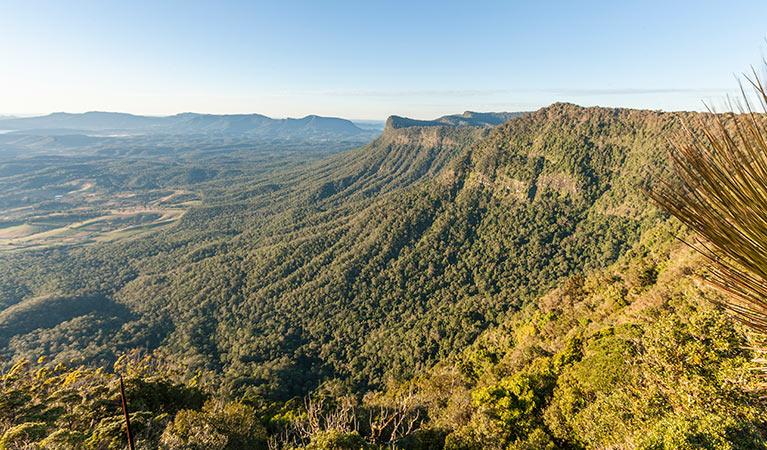
The dramatic landscapes of the Border Ranges National Park echo the historical ties connecting the region's Aboriginal people to Country. The Githabul People trace their identity and spirituality to this Country and it is central to their Dreaming. The park protects many ancient sites and continues to be a place of great significance today.
Plants and animals protected in this park
Animals
-

Albert's lyrebird (Menura alberti)
The Albert’s lyrebird is much rarer than the superb lyrebird. Distinguished by its richer brown plumage and less elaborate tail feathers, it’s protected as a threatened species in NSW.
-

Spotted-tailed quoll (Dasyurus maculatus)
The spotted-tailed quoll is the largest remaining carnivorous marsupial on the Australian mainland. It’s protected as a vulnerable species in NSW.
-

Satin bowerbird (Ptilonorhynchus violaceus)
With vibrant blue-violet eyes and curious antics, the satin bowerbird is a favourite for bird watching and easy to spot as it forages for food in open forest. Relatively common across eastern Australia, in NSW they’re found in coastal rainforests and adjacent woodlands and mountain ranges.
-

Wompoo fruit-dove (Ptilinopus magnificus)
The wompoo fruit-dove is a marvellously multi-coloured pigeon that makes its home in rainforest along coastal ranges from mid-north NSW to southern Queensland. It’s protected as a vulnerable species in NSW.
-

Rufous scrub-bird (Atrichornis rufescens)
The vulnerable rufous scrub-bird is a small, ground-foraging bird that lives only in isolated rainforest areas of south-eastern Australia.
-

Common ringtail possum (Pseudocheirus peregrinus)
Commonly found in forests, woodlands and leafy gardens across eastern NSW, the Australian ringtail possum is a tree-dwelling marsupial. With a powerful tail perfectly adapted to grasp objects, it forages in trees for eucalypt leaves, flowers and fruit.
-

Long-nosed bandicoot (Perameles nasuta)
A nocturnal marsupial and one of the smaller Australian native animals, the long-nosed bandicoot is found across eastern Australia. Populations in the Sydney region have dwindled since European settlement, leaving only endangered colonies in inner western Sydney and at North Head, near Manly. The long-nosed bandicoot has grey-brown fur and a pointed snout which it uses to forage for worms and insects.
-

Koala (Phascolarctos cinereus)
One of the most renowned Australian animals, the tree-dwelling marsupial koala can be found in gum tree forests and woodlands across eastern NSW, Victoria and Queensland, as well as in isolated regions in South Australia. With a vice-like grip, this perhaps most iconic but endangered Australian animal lives in tall eucalypts within a home range of several hectares.
-

Fleay's barred frog (Mixophyes fleayi)
The Fleay’s barred frog is an endangered species restricted to rainforest stream habitats in north-east NSW and south-east Queensland.
-

Eastern bristlebird (Dasyornis brachypterus)
The endangered eastern bristlebird is a shy, ground-dwelling songbird. Less than 2,500 birds are left in the wild, restricted to 3 isolated areas in eastern NSW and southern Queensland.
Plants
-

Grass tree (Xanthorrea spp.)
An iconic part of the Australian landscape, the grass tree is widespread across eastern NSW. These Australian native plants have a thick fire-blackened trunk and long spiked leaves. They are found in heath and open forests across eastern NSW. The grass tree grows 1-5m in height and produces striking white-flowered spikes which grow up to 1m long.
Environments in this park
Education resources (1)
What we're doing
Border Ranges National Park has management strategies in place to protect and conserve the values of this park. View the detailed park and fire management documents. Here is just some of the work we’re doing to conserve these values:
Preserving biodiversity
The World Heritage-listed wilderness in Border Ranges National Park houses a wealth of unique fauna. Maintaining biodiversity within the park is a continuing priority for NPWS, so efforts to support threatened species are ongoing. These efforts include regular surveying and monitoring, pest management strategies, initiatives to boost key populations, fire management implementation, staff training and continuing bush regeneration programs.
Managing weeds, pest animals and other threats
Pests and weeds have a significant impact to the ecosystems within Border Ranges National Park. Pest management is a priority for NPWS with the pest reduction of wild dogs and cane toads being an important part of the work to protect the integrity of biodiversity within this park. Risk assessments for new and emerging weeds are carried out as an ongoing initiative in Border Ranges.
Exploring World Heritage
Border Ranges National Park is part of the Gondwana Rainforests of Australia World Heritage Area. The park’s World Heritage values are preserved through multiple conservation programs, including fire and pest management strategies and initiatives to help recover threatened species. NPWS training aims to optimise staff understanding of World Heritage values, and the service promotes community involvement in conserving this important park.
Conserving our Aboriginal culture
Border Ranges National Park is dedicated to preserving its strong Aboriginal culture. There are several significant sites within the park, which are maintained as part of efforts to conserve its heritage. Aboriginal site conditions are regularly assessed and recorded, and members of the Githabul community are consulted on park management decisions as a matter of course.
Managing fire
NSW is one of the most bushfire prone areas in the world as a result of our climate, weather systems, vegetation and the rugged terrain. NPWS is committed to maintaining natural and cultural heritage values and minimising the likelihood and impact of bushfires via a strategic program of fire research, fire planning, hazard reduction, highly trained rapid response firefighting crews and community alerts.

